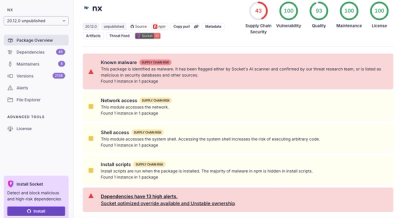
Security News
Risky Biz Podcast: Making Reachability Analysis Work in Real-World Codebases
This episode explores the hard problem of reachability analysis, from static analysis limits to handling dynamic languages and massive dependency trees.
gazelle-component-ui
Advanced tools
Gazelle Component UI is a library of reusable UI components for Next.js & React applications. This library aims to provide a set of well-designed and accessible components to speed up the development process and ensure consistency across the Gazelle application.
📁 Refer to src/components to see the list of available components or check them out directly on the Storybook page.
Additionally, our component library provides a set of generic hooks that can seamlessly integrate into your applications. These hooks offer versatile functionality, enhancing flexibility and extensibility.
📁 Refer to src/hooks to see the list of available hooks.
⚠️ *Note: This library is actively maintained and regularly updated with new features and improvements. So do not forget to upgrade the library.*
You can install the gazelle-component-ui package via npm:
npm install gazelle-component-ui
To use the components from gazelle-component-ui in your React application, import the desired component and use it
like any other React component.
A simple button component with various customization options.
| Prop | Type | Description |
|---|---|---|
| id | string | Id for automatic test |
| children | node | Content of the button. |
| type | union | button |
| title | string | Title attribute for the button. |
| ariaLabel | string | ARIA label for accessibility. |
| variant | union | primary, secondary or validation |
Here is an example demonstrating how to use a Button component from the library:
import React from "react";
import { Button } from "gazelle-component-ui";
const App = () => {
return (
<div>
<h1>Welcome to Gazelle Component UI</h1>
<Button id={id} type={type} title={title} aria-label={ariaLabel} onClick={() => alert("Button clicked!")} variant={primary}>
Click Me
</Button>
</div>
);
};
export default App;
Use the basic test command to execute all unit tests
npm run test
To generate a code coverage report, use:
npm run test:coverage
This will output the test coverage details, indicating how much of your code is tested.
For an interactive user interface to explore test coverage, run:
npm run vitest:coverage
This starts Vitest’s UI with test and coverage details accessible in the browser.
We use Storybook to document and showcase the components provided by Gazelle Component UI. Storybook provides an interactive UI environment where you can browse, view, and test components in isolation.
To view the documentation and interact with the components in Storybook:
git clone https://gitlab.inria.fr/gazelle/private/new-gazelle/user-interface/gazelle-component-lib.git
npm install
npm run storybook
Navigate to http://localhost:6006 to view the Storybook interface.
In the Storybook interface, you can:
Browse Components: Navigate through the list of available components.
View Documentation: Read detailed documentation for each component, including props and usage examples.
Interact with Components: Test and interact with components in real-time.
In order to use this library in all other Next-JS projects, we need to publish the components on a registry.
For registry, we are using https://www.npmjs.com.
Check that you are authenticated to the registry (npm whoami), if not, use the command npm adduser.
Check the version in your package.json. You can't push a library on an existing version.
Two methods are available to test your new component in your current application, follow these steps:
Ensure your component is built and ready for use by running:
npm run build
Link your component globally in your development environment:
npm link
In the application or repository where you want to test the component, run:
npm link gazelle-component-ui
Ensure your component is built and ready for use by running:
npm run build
Create a local tarball package of your component library:
npm pack
This command will generate a file named gazelle-component-ui-{VERSION}.tgz in your project root directory, where {VERSION} matches the version in your package.json.
In the application where you want to test the component, install the local package using the absolute path to the tarball:
# If using npm
npm install /absolute/path/to/gazelle-component-ui-{VERSION}.tgz
# If using pnpm
pnpm install /absolute/path/to/gazelle-component-ui-{VERSION}.tgz
Replace /absolute/path/to/ with the actual path to your component library directory.
Note: This approach creates a more realistic testing environment as it exactly replicates how the package would behave when installed from the npm registry.
Once you’ve tested your component and are ready to publish a new version to the npm registry, follow these steps:
Use the following command to update your package version:
npm version patch
Publish the new version of your package:
npm publish
✅ Don't forget to push your changes to the library repository to ensure the latest updates are tracked and shared.
Once published, verify the package on the npm registry:
npm install gazelle-component-ui
Once the library is pushed, you can go to your Next-JS application to change the library version in the package.json.
Execute the npm install command. You can now use the components you developed.
Copyright 2022-2025 IHE International
Licensed under the Apache License, Version 2.0 (the "License");
you may not use this file except in compliance with the License.
You may obtain a copy of the License at
http://www.apache.org/licenses/LICENSE-2.0
Unless required by applicable law or agreed to in writing, software
distributed under the License is distributed on an "AS IS" BASIS,
WITHOUT WARRANTIES OR CONDITIONS OF ANY KIND, either express or implied.
See the License for the specific language governing permissions and
limitations under the License.
FAQs
Gazelle Component UI
The npm package gazelle-component-ui receives a total of 39 weekly downloads. As such, gazelle-component-ui popularity was classified as not popular.
We found that gazelle-component-ui demonstrated a healthy version release cadence and project activity because the last version was released less than a year ago. It has 0 open source maintainers collaborating on the project.
Did you know?

Socket for GitHub automatically highlights issues in each pull request and monitors the health of all your open source dependencies. Discover the contents of your packages and block harmful activity before you install or update your dependencies.

Security News
This episode explores the hard problem of reachability analysis, from static analysis limits to handling dynamic languages and massive dependency trees.

Security News
/Research
Malicious Nx npm versions stole secrets and wallet info using AI CLI tools; Socket’s AI scanner detected the supply chain attack and flagged the malware.

Security News
CISA’s 2025 draft SBOM guidance adds new fields like hashes, licenses, and tool metadata to make software inventories more actionable.